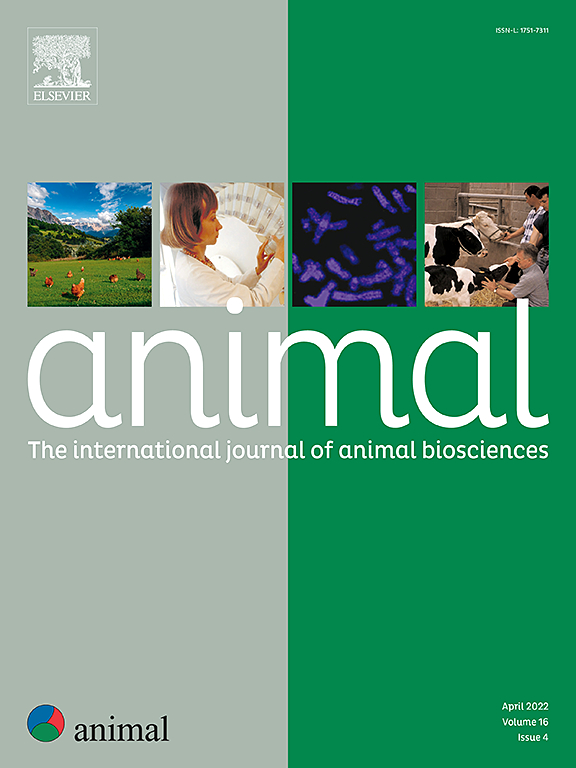评价生长猪对生物精制饲料作物的蛋白质消化率:植物种类和沉淀方法的影响。
IF 4.2
2区 农林科学
Q1 AGRICULTURE, DAIRY & ANIMAL SCIENCE
引用次数: 0
摘要
生物精制饲料蛋白显示出作为单胃动物蛋白质替代品的潜力。实现高蛋白质质量是在粮食生产系统中有效整合替代蛋白质来源的核心。然而,对植物种类和加工参数如何影响提取的蛋白质质量的了解有限。本研究的目的是评价85°C沉淀的生物精制红三叶草、黄草和苜蓿中CP和氨基酸(AA)的回肠消化率。对于lucerne,该研究还旨在确定替代沉淀方法(60°C,两步加热方法(55 + 85°C),发酵和85°C热处理前的离心)的效果。据推测,与红三叶草和日黄相比,生物精制苜蓿具有更好的蛋白质消化率。进一步加工可以提高粗蛋白质含量,但会降低消化率。通过生物精炼从新鲜收获的生物质中提取蛋白质。采用不完全拉丁方设计,选取8头初始体重30.7 kg的雄性去势猪,在回肠末端安装t型套管,评估CP和AA的标准化回肠消化率(SID)。通过饲喂无氮日粮估计CP和AA的内源性损失。结果表明,从饲料作物中可提取出CP含量在488 ~ 628 g/kg DM之间的富蛋白质浓缩物,其组成受植物种类选择和应用生产方式的显著影响。红三叶草蛋白质的CP标准化回肠消化率(69.3%)显著低于苜蓿(79.6%)和猪粪(77.0%,P = 0.0013)。85°C沉淀的Lucerne蛋白CP SID数值最高,交替沉淀对CP和AA的SID没有改善作用。85°C沉淀法提取的芦花素和猪黄蛋白可消化必需氨基酸含量较高,但后者的总CP SID较低。综上所述,可以通过饲料作物的生物精制生产高蛋白浓缩物,特别是从苜蓿和猪粪中提取。所选择的沉淀方法对蛋白质的品质和组成有显著影响,以85℃热沉淀法消化率最佳。猪黄菌和紫花苜蓿因其高可消化AA含量而成为有前途的蛋白质替代品。本文章由计算机程序翻译,如有差异,请以英文原文为准。
Evaluating protein digestibility of biorefined forage crops in growing pigs: effects of plant species and precipitation methods
Biorefined forage proteins show potential as protein alternatives for monogastric animals. Achieving high protein quality is central for the effective integration of alternative protein sources in food production systems. However, there is a limited understanding of how plant species and processing parameters influence the quality of the extracted proteins. The aim of the study was to evaluate the ileal digestibility of CP and amino acids (AA) in biorefined red clover, festulolium and lucerne precipitated at 85 °C. For lucerne, the study additionally aimed to determine the effect of alternative precipitation methods (60 °C, a two-step heating method (55 + 85 °C), fermentation, and centrifugation prior to 85 °C heat treatment). It was hypothesised that biorefined lucerne would have superior protein digestibility compared to red clover and festulolium. Furthermore, while CP content could be increased through further processing, such enhancement would reduce digestibility. Protein was extracted from the freshly harvested biomass through biorefining. The standardised ileal digestibility (SID) of CP and AA was evaluated in an incomplete Latin square design with eight male castrated pigs (initial weight 30.7 kg) fitted with a T-cannula in the terminal ileum. Endogenous losses of CP and AA were estimated by feeding an N-free diet. Results demonstrated that protein-rich concentrates with CP contents ranging between 488 and 628 g/kg DM could be extracted from the forage crops, with the composition significantly influenced by the choice of plant species and the applied production methods. Standardised ileal digestibility of CP was significantly lower in protein extracted from red clover (69.3%) compared to lucerne (79.6%) and festulolium (77.0%, P = 0.0013). Lucerne protein precipitated at 85 °C exhibited the numerically highest CP SID and alternative precipitation did not improve the SID of CP and AA. Protein extracted from lucerne and festulolium using precipitation at 85 °C had a high content of digestible essential AA, despite lower overall CP SID in the latter. In conclusion, high-protein concentrates can be produced through biorefining of forage crops, particularly from lucerne and festulolium. The protein quality and composition are significantly affected by the chosen precipitation method, with 85 °C heat precipitation showing the best results in terms of digestibility. Festulolium and lucerne emerge as promising protein alternatives due to their high digestible AA content.
求助全文
通过发布文献求助,成功后即可免费获取论文全文。
去求助
来源期刊

Animal
农林科学-奶制品与动物科学
CiteScore
7.50
自引率
2.80%
发文量
246
审稿时长
3 months
期刊介绍:
Editorial board
animal attracts the best research in animal biology and animal systems from across the spectrum of the agricultural, biomedical, and environmental sciences. It is the central element in an exciting collaboration between the British Society of Animal Science (BSAS), Institut National de la Recherche Agronomique (INRA) and the European Federation of Animal Science (EAAP) and represents a merging of three scientific journals: Animal Science; Animal Research; Reproduction, Nutrition, Development. animal publishes original cutting-edge research, ''hot'' topics and horizon-scanning reviews on animal-related aspects of the life sciences at the molecular, cellular, organ, whole animal and production system levels. The main subject areas include: breeding and genetics; nutrition; physiology and functional biology of systems; behaviour, health and welfare; farming systems, environmental impact and climate change; product quality, human health and well-being. Animal models and papers dealing with the integration of research between these topics and their impact on the environment and people are particularly welcome.
 求助内容:
求助内容: 应助结果提醒方式:
应助结果提醒方式:


